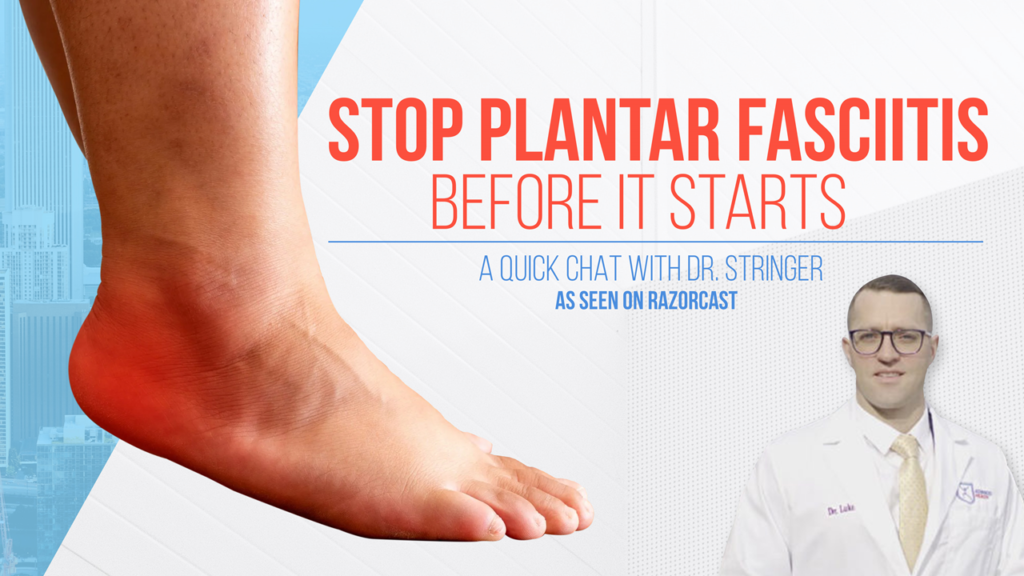Plantar fasciitis is the term used to describe the heel pain caused by inflammation of the fascia, which is the connective tissue between the bottom of your heel bone and your foot. Classic symptoms are pain and inflammation in and around the heel or in the mid part of the foot. It can be really painful, especially in the morning when you get out of bed. Here are some tips for preventing yourself from getting plantar fasciitis.
Improve the Range of Motion in Your Foot and Ankle: It is really important to have good ergonomics and biomechanics of the foot and the ankle. Limited range of motion in what we call dorsiflexion, that’s you actually flexing your foot and ankle towards you, leads to plantar fasciitis. When we have limited range of motion in the foot and the ankle and then you do repetitive activity like running and dancing, because you’re repetitively using the foot and ankle with a joint that’s not moving well, this breaks down the fascia, which anchors your heel and your foot together, forming adhesions and scar tissue and then that just leads to pain and inflammation.
There are good rehab exercises we do in the office with people that are suffering with poor balance or pain in foot and ankle. We often do the rehab in a bare foot because you can really grip the floor. You can switch on those muscles in your foot and then you can really build a strong and stable foot.
Wear Proper Footwear: I feel that our shoes nowadays have far too much support in them. They have those big spongy heels; it’s kind of like you’re walking on a cloud, you float along. Well then, you’ve got muscles, ligaments, tendons in the foot and when they’re working and when they’re active, they’re nice and stable so it’s going to support your foot and ankle. However, when we put these big, kind of comfy shoes on and then you’re doing the same activity, well, that’s essentially creating weakness in the foot and ankle because the shoe’s absorbing a lot of the force and it’s not really putting much pressure into the foot and ankle. That is going to create kind of lazy muscles, ligaments and tendons in the foot and ankle. Now let’s imagine you were wearing comfy shoes all week and then you went to the beach and you did a 5-mile run with no shoes on. Well, you’ve gone from 0 to 100 really quickly. That could create inflammation in the foot.
If you’re wearing a comfy shoe, make sure you’re out of it a bunch, and if you don’t wear a comfy shoe and you prefer to be barefoot, make sure you’re not putting 10, 15,000 steps a day into that foot because as we’ve evolved, our foot and ankle isn’t necessarily ready to take that kind of force.
Get Orthotics: If you’ve got a high arch or a flat arch, that can also affect how you load your foot. The ergonomics of your foot can certainly affect how your foot and ankle functions. You can have too high of an arch or you can have too flat of a foot. And if you do have high arches or flat feet, you should certainly reach out to your chiropractor or podiatrist and look into getting some orthotics, just to create some even load into the foot and ankle. Because like we said, how you load a joint dictates how it moves and how much it moves, dictates the stress and tension you’re putting into the tissue and that dictates how healthy the joint is.
Watch Your Weight: If you’re overweight, you’re going to increase the load within your joints from your lower back, to your hips, your knees, your foot and ankle. If a joint is overloaded, it’s going to have to work harder. And if the joint’s working harder, the soft tissue that moves and stabilizes that joint is going to work harder, so over time that’s going to break down quicker than someone who’s not putting too much load into the foot and ankle. Now is everyone who’s overweight or has a high BMI going to get foot and ankle pain? Absolutely not. It’s going to be case specific. Now, if you combine people who are high in their BMI and overweight with really poor ankle range of motion, then they’re going to have a higher incidence of foot and ankle pain and a higher chance for developing plantar fasciitis.

